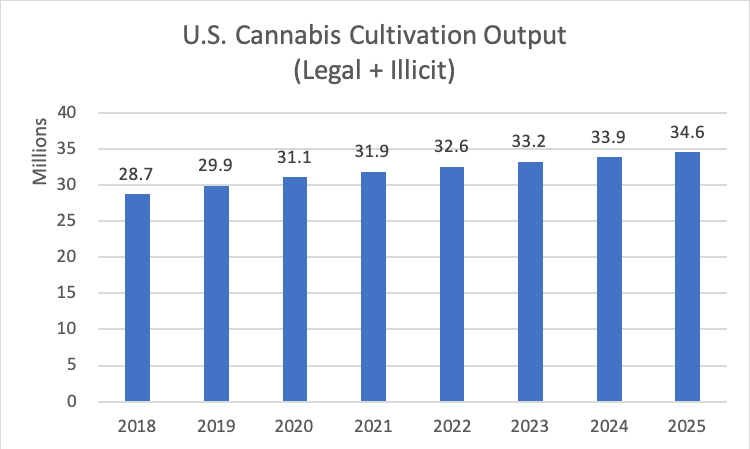Bearing Fruit from U.S. Cultivation Output Estimates for 2019

Canadian CBD Usage
October 27, 2019
U.S. Cannabis Cultivation Output
November 3, 2019By New Frontier Data
While there has been much discussion about the total demand in the cannabis market, the trends in consumer and products preferences, and how policies are shaping business opportunities, often overlooked has been the status of cannabis supply throughout the United States. In its forthcoming report, U.S. Cannabis Cultivation Output Estimates (2019), New Frontier Data provides cultivation output estimates for each state, differentiating between legal and illicit cultivation.
“This is a first-of-its-kind of report”, explained Beau Whitney, New Frontier Data’s Senior Economist. Most supply updates look only at the legal markets, but the new report provides the total volume being cultivated in the U.S. “The output being produced in the U.S. is staggering, particularly in California,” he added.
The total amount produced in the U.S. in 2019 is estimated to reach 29.9 million pounds. While California accounts for roughly 58% of all cannabis cultivated in the U.S., Oregon, Washington, Colorado, and Florida round out the top five producing states

In addition to flower, the total output includes cultivation produced for extraction, along with other derivative products.
“This data can be used in a variety of ways, including to formulate business plans, assess market potential and develop target markets for market entry strategies.” Whitney said. “This data can fill in the entire picture associated with both supply and demand of cannabis in the U.S.”
Based on the report, while a majority of California and Oregon supply is cultivated outdoors, that is not the case throughout the U.S. While more cultivation overall is done outdoors (44%), both indoor (27%) and greenhouse (29%) grows hold their fair share. This data can also help to determine how much environmental impact cannabis has in the U.S., and contribute to other policy-related discussions.
The U.S. cultivation output data offers a vital basis for grounding discussions about the future of the nascent legal industry.




